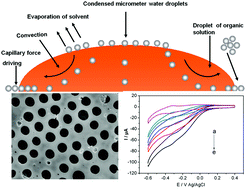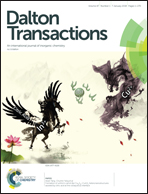Honeycomb-patterned hybrid films of surfactant-encapsulated polyoxometalates by a breath figure method and its electrocatalysis for BrO3−†
Abstract
In this paper, a sandwich type of polyoxophosphotungstate K7Na3[Cu4(H2O)2(PW9O34)2]·20H2O (abbr. Cu4(PW9)2) was selected as an active unit to construct inorganic/organic hybrid materials. The ordered honeycomb structure of the surfactant-encapsulated polyoxometalate (SEP) complex was successfully obtained by using a famous breath figure method. Cu4(PW9)2 maintains typical features as confirmed by IR spectra, magnetization hysteresis studies and UV-vis spectra. An investigation of the effects of the relative humidity on the morphology of the honeycomb structures demonstrated a wide generality and high reproducibility of the formation of self-organized honeycomb-patterned films. In the present experiment, this magnetically ordered honeycomb was successfully deposited on indium tin oxide (ITO) substrates by directly casting the SEP chloroform solution. The cyclic voltammetric responses showed the redox couples of Cu4(PW9)2. The electrochemical behavior of the electrode was studied. In addition, the modified electrode exhibited high electrocatalytic activity for the reduction of BrO3−, which offered a new POM-based film material for the electrochemical fields.



 Please wait while we load your content...
Please wait while we load your content...